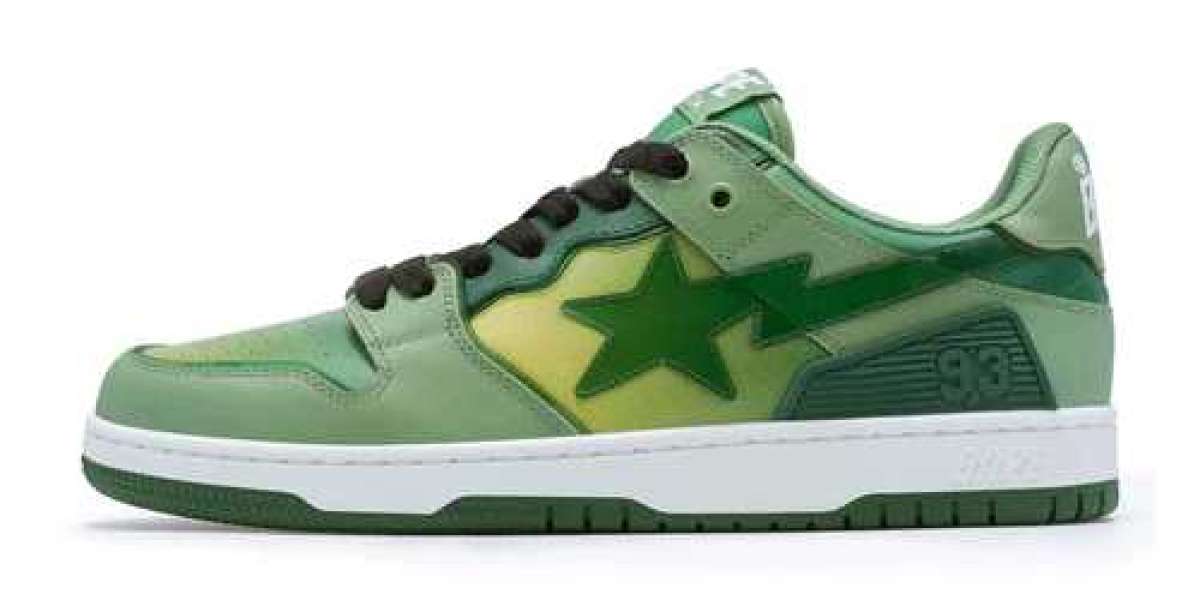Streetwear and sneaker culture are constantly evolving, but some silhouettes manage to stand the test of time. Among them, the Bapesta stands out not just as a sneaker, but as a cultural statement. Born from the intersection of Japanese street fashion and American hip-hop aesthetics, the Bapesta has cemented its legacy over the last two decades. For many, it's more than just a shoe—it’s a symbol of identity, rebellion, and status.
The Origins of the Bapesta: A Japanese Vision with Global Appeal
The Bapesta was first introduced in the early 2000s by A Bathing Ape (BAPE), a Japanese streetwear label founded by Nigo in 1993. Inspired heavily by American street culture and sneaker trends of the late 1990s, Nigo reimagined Nike’s Air Force 1 with a unique twist. The result was the Bapesta: a sneaker with an unmistakable star logo replacing the Nike Swoosh, patent leather materials, and bold, colorful designs that were unheard of at the time.
While comparisons to the Air Force 1 were inevitable—and intentional—the Bapesta brought a whole new dimension to sneaker culture. It was flashy, unapologetic, and infused with Japanese craftsmanship and pop culture references. Rather than being seen as a copy, it was celebrated as an homage and a reinvention.
Early Popularity and Celebrity Endorsements
The early 2000s were a golden era for the Bapesta, especially thanks to co-signs from hip-hop artists and streetwear influencers. Names like Pharrell Williams, Kanye West, and Lil Wayne helped elevate the Bapesta from a niche item to a globally recognized symbol of cool. In music videos, album covers, and red carpet appearances, the Bapesta became an essential part of the early 2000s aesthetic.
Pharrell, in particular, played a crucial role in spreading BAPE’s influence to Western audiences. Through collaborations and his own ventures like Billionaire Boys Club, he integrated the Bapesta into the broader conversation around fashion and music. These organic endorsements gave the shoe authenticity and street credibility that few brands could replicate.
Design Language: What Makes the Bapesta Stand Out
One look at a Bapesta, and it's easy to see why it's so beloved. The sneaker typically features glossy patent leather, vibrant color blocking, and the iconic "STA" logo—an angular star shooting across the side panel. It’s loud, proud, and anything but minimalist.
Colorways are one of the defining elements of the Bapesta. From camo-clad uppers to neon pastels and candy-toned designs, Bapesta drops are designed to stand out. Over the years, BAPE has also released limited-edition versions featuring characters like SpongeBob SquarePants, Marvel superheroes, and even tie-ins with global artists and brands. These collaborations keep the Bapesta fresh and culturally relevant, even decades after its debut.
Bapesta vs Air Force 1: A Cultural Comparison
The comparisons between the Bapesta and Nike’s Air Force 1 are inevitable—and valid. Both share a similar silhouette and originally targeted the same audience. But the real difference lies in their cultural positioning.
The Air Force 1 is rooted in classic American sportswear. It represents heritage, legacy, and consistency. The Bapesta, on the other hand, is flamboyant, experimental, and deeply intertwined with streetwear as a form of expression. While the AF1 fits seamlessly into a clean outfit, the Bapesta demands attention.
In many ways, the Bapesta is the AF1’s rebellious cousin—just as street-savvy but twice as flashy.
The Evolution of the Bapesta: Then and Now
The Bapesta has gone through multiple iterations since its launch. After a brief period of decreased visibility in the mid-2010s, the sneaker saw a powerful resurgence with the rise of vintage streetwear and Gen Z’s obsession with Y2K fashion.
BAPE responded with a renewed focus on quality, updated silhouettes, and collaborative collections that tapped into modern sensibilities. From high-fashion tie-ins to artist-led drops, the Bapesta returned stronger than ever—striking a balance between nostalgia and innovation.
In 2021, BAPE even re-engineered the Bapesta for improved comfort and durability, offering fans a more wearable version of the classic model while retaining its iconic look.
Collectibility and Resale Culture
The Bapesta is not just worn—it’s collected. Vintage pairs from the early 2000s, especially those tied to rare collaborations, fetch high prices on resale platforms. Collectors view Bapestas as wearable art, and each drop has the potential to become a future grail.
Unlike mass-produced sneakers, many Bapesta models are released in limited runs. This scarcity adds to their allure. Whether it's a special anniversary edition or a regional exclusive, each pair carries a story that resonates with sneakerheads around the world.
Bapesta in Pop Culture Today
Even today, the Bapesta maintains its cultural relevance. It frequently appears in music videos, street style photography, and fashion editorials. Celebrities like Offset, Travis Scott, and Jaden Smith have all been spotted rocking Bapestas, signaling their continued influence on modern streetwear.
Social media platforms like Instagram and TikTok have also played a major role in the shoe’s comeback. Gen Z creators and fashion influencers are styling vintage pairs with baggy jeans, oversized graphic tees, and puffer jackets—reviving early 2000s aesthetics for a new audience.
How to Style the Bapesta: Fashion Tips for Sneakerheads
Styling Bapestas requires a bold hand. These aren’t your typical minimalist white sneakers—they’re loud and designed to be noticed. For a classic streetwear look, pair them with cargo pants, a graphic hoodie, and a BAPE cap. Want to go high fashion? Style them with tailored trousers, a cropped jacket, and statement accessories.
One popular approach is to let the Bapesta be the centerpiece of the outfit. Choose a more neutral fit and allow the sneaker’s vibrant colors or patterns to steal the spotlight. The goal is balance—letting the shoes speak without overwhelming your overall look.
Bapesta’s Legacy and Future in Streetwear
The Bapesta has done more than just survive in the competitive world of sneakers—it has thrived. As trends come and go, the Bapesta remains a constant fixture, beloved for its fearless design and cultural significance.
Looking forward, the future seems bright. With continued collaborations, evolving materials, and a strong global fanbase, the Bapesta is set to influence a whole new generation of streetwear enthusiasts. Its ability to bridge the past and present makes it not just a fashion piece, but a historical artifact of street culture.
Final Thoughts
The Bapesta isn’t just another sneaker on the shelf—it’s a statement. Born from the creative mind of Nigo and nurtured by global tastemakers, it has become a symbol of everything streetwear represents: creativity, rebellion, culture, and community.














